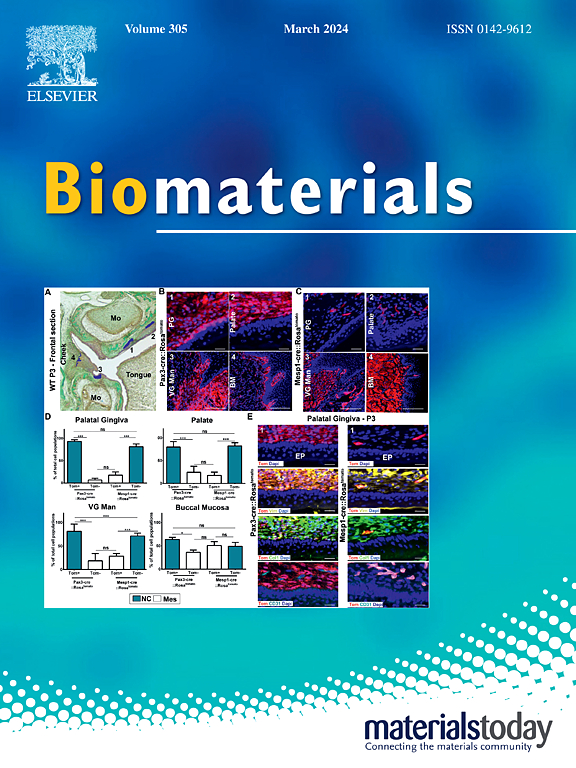磁控干细胞微凝胶机器人治疗间质性膀胱炎
IF 12.8
1区 医学
Q1 ENGINEERING, BIOMEDICAL
引用次数: 0
摘要
干细胞治疗慢性膀胱疾病如间质性膀胱炎/膀胱疼痛综合征(IC/BPS)已被广泛研究。然而,由于膀胱壁上的黏液层和频繁的排尿,导致干细胞从膀胱中快速清除,干细胞进入膀胱壁受到限制。在这里,我们报道了一种由磁性纳米链嵌入微凝胶组成的软微凝胶(μgelbot),其大小和形状可调,用于增强间充质干细胞(MSCs)通过黏液层进入膀胱壁的递送。体外穿透实验表明,在旋转磁场作用下,四边形μ凝胶机器人能有效地对周围剪切变薄的黏液层施加剪切力,增强了μ凝胶机器人的穿透能力。在μgelbot上加载MSCs后,我们证实了MSCs在重建黏液层中的渗透性和滞留性增强。最后,我们成功地证明了MSCs负载μ凝胶机器人在慢性IC小鼠模型上的旁分泌作用,抑制肥大细胞浸润、胶原沉积和膀胱细胞凋亡。综上所述,我们可以证实磁控μ凝胶机器人作为干细胞治疗IC/BPS的一个有前景的平台的可行性。本文章由计算机程序翻译,如有差异,请以英文原文为准。

Magnetically controlled microgelbots with stem cells for the treatment of interstitial cystitis
Stem cell therapy has been widely investigated for the treatment of chronic bladder diseases such as interstitial cystitis/bladder pain syndrome (IC/BPS). However, the delivery of stem cells into the bladder wall is limited due to the mucus layer lining the bladder wall and the frequent urination, leading to the fast clearance of stem cells from the bladder. Here, we report a soft microgelbot (μgelbot) composed of a magnetic nanochain embedded microgel in a tunable size and shape for the enhanced delivery of mesenchymal stem cells (MSCs) into the bladder wall through the mucus layer. In vitro penetration tests to optimize the shape of μgelbots show that the quadrangle shaped μgelbots effectively apply a shear force to the surrounding shear-thinning mucus layer for the enhanced penetration under a rotating magnetic field. After loading MSCs onto the μgelbot, we confirm the enhanced penetration and retention in the reconstructed mucus layer. Finally, we successfully demonstrate the paracrine effects of MSCs loaded μgelbots on chronic IC murine models, inhibiting the mast cell infiltration, collagen deposition, and bladder cell apoptosis. Taken together, we could confirm the feasibility of magnetically controlled μgelbots as a promising platform for the stem cell therapy of IC/BPS.
求助全文
通过发布文献求助,成功后即可免费获取论文全文。
去求助
来源期刊

Biomaterials
工程技术-材料科学:生物材料
CiteScore
26.00
自引率
2.90%
发文量
565
审稿时长
46 days
期刊介绍:
Biomaterials is an international journal covering the science and clinical application of biomaterials. A biomaterial is now defined as a substance that has been engineered to take a form which, alone or as part of a complex system, is used to direct, by control of interactions with components of living systems, the course of any therapeutic or diagnostic procedure. It is the aim of the journal to provide a peer-reviewed forum for the publication of original papers and authoritative review and opinion papers dealing with the most important issues facing the use of biomaterials in clinical practice. The scope of the journal covers the wide range of physical, biological and chemical sciences that underpin the design of biomaterials and the clinical disciplines in which they are used. These sciences include polymer synthesis and characterization, drug and gene vector design, the biology of the host response, immunology and toxicology and self assembly at the nanoscale. Clinical applications include the therapies of medical technology and regenerative medicine in all clinical disciplines, and diagnostic systems that reply on innovative contrast and sensing agents. The journal is relevant to areas such as cancer diagnosis and therapy, implantable devices, drug delivery systems, gene vectors, bionanotechnology and tissue engineering.
 求助内容:
求助内容: 应助结果提醒方式:
应助结果提醒方式:


